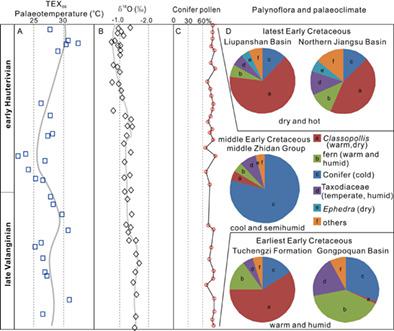当前位置:
X-MOL 学术
›
Geolog. J.
›
论文详情
Our official English website, www.x-mol.net, welcomes your
feedback! (Note: you will need to create a separate account there.)
Conifer‐dominant palynoflora from the Lower Cretaceous in Ordos Basin, China: Biostratigraphical and palaeoclimatic implications
Geological Journal ( IF 1.4 ) Pub Date : 2020-10-07 , DOI: 10.1002/gj.4015 Mingzhen Zhang 1, 2 , Shuang Dai 2 , Xianwen Zhang 3 , Sen Wang 2 , Zhen Du 2 , Bo Ma 1 , Baoxia Du 2
Geological Journal ( IF 1.4 ) Pub Date : 2020-10-07 , DOI: 10.1002/gj.4015 Mingzhen Zhang 1, 2 , Shuang Dai 2 , Xianwen Zhang 3 , Sen Wang 2 , Zhen Du 2 , Bo Ma 1 , Baoxia Du 2
Affiliation

|
Open oceanic and coastal marine sedimentary rocks provide abundant valuable records of Cretaceous greenhouse climates, but limited information is available regarding the Cretaceous continental climate regimes. This study presents a palynological report from the middle Zhidan Group based on the ZK1046 drillcore in the southwestern Ordos Basin of central China. A total of 52 types of palynomorphs including 15 genera of spores (20 species) and 24 genera of gymnosperm pollen (34 species) were recognized in the palynological assemblages. Upwards from the base, the palynomorph assemblages in the ZK1046 drill core were not very diverse. They were dominated by bisaccates and proto‐saccate pollen (around 80%), followed by some fern spores and a low content of Classopollis (below 10%). The overall characteristics of the palynomorph assemblages and some biostratigraphically significant palynomorph genera, such as Ephedripites, Jugella, and Rugubivesiculites, suggest that the middle Zhidan Group dates from the middle Early Cretaceous (probably Hauterivian). Vegetation reconstruction points to conifer‐dominated forests with subordinate pteridophyte, Taxodiaceae, and a few Cheirolepidiaceae plants, indicating a relatively stable, cold, and slightly humid environment. This climatic condition was a likely response to the relatively cool global climate during the middle Early Cretaceous.
更新日期:2020-10-07











































 京公网安备 11010802027423号
京公网安备 11010802027423号